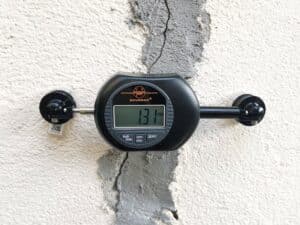Vous souhaitez un renseignement pour
G1.5 Gauge
Pour obtenir un devis ou nous poser des questions sur le produit, n’hésitez pas à nous contacter :
- par email sur info@saugnac-jauges.fr
- par téléphone au 09 62 07 18 68 (prix d’un appel local)
128,50€ w/o VAT

Technical Specifications
|
||||
Overview of the G1.5 Crack GaugeThe G1.5 crack monitor is a precision device designed for tracking and monitoring crack width variations. It stands out for its carbon construction and its 0.02 mm resolution. Carbon offers two key benefits:
Thanks to its design, the G1.5 gauge is reusable. The 0.02 mm resolution enables highly accurate movement tracking. Readings are taken using a vernier principle, as with all models in the G1 family. The crack monitor consists of two carbon rules sliding within PA12 Nylon clips—a polyamide known for its excellent dimensional stability and high weather resistance. Markings are pad printed and UV-resistant. The G1.5 gauge is supplied with impact anchors for mechanical fastening. It features two Ø 4 mm holes for installation. Fastening is done through the device (the anchor’s shoulder overlaps the crack monitor). Each G1.5 device has a unique ID in QR format, enabling tracking via the free application available at https://saugnac.app. The app allows: |
||||
Reading PrincipleUse the provided magnifier to read the measurement. The upper scale, graduated from 0 to 100 mm, represents the main measurement scale. The lower scale corresponds to the vernier. Reading method:
Examples:
|

Removable digital crackmeter. 1-axis or 2-axis tracking. Resolution: 0.01 mm.
Pour obtenir un devis ou nous poser des questions sur le produit, n’hésitez pas à nous contacter :
If you would like a quotation or have any questions about the product, please contact us: